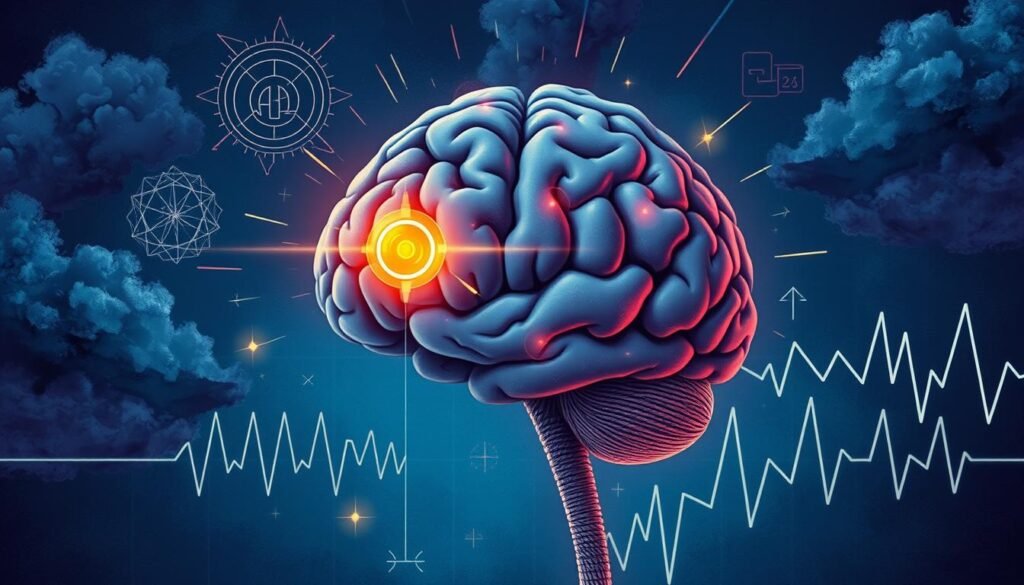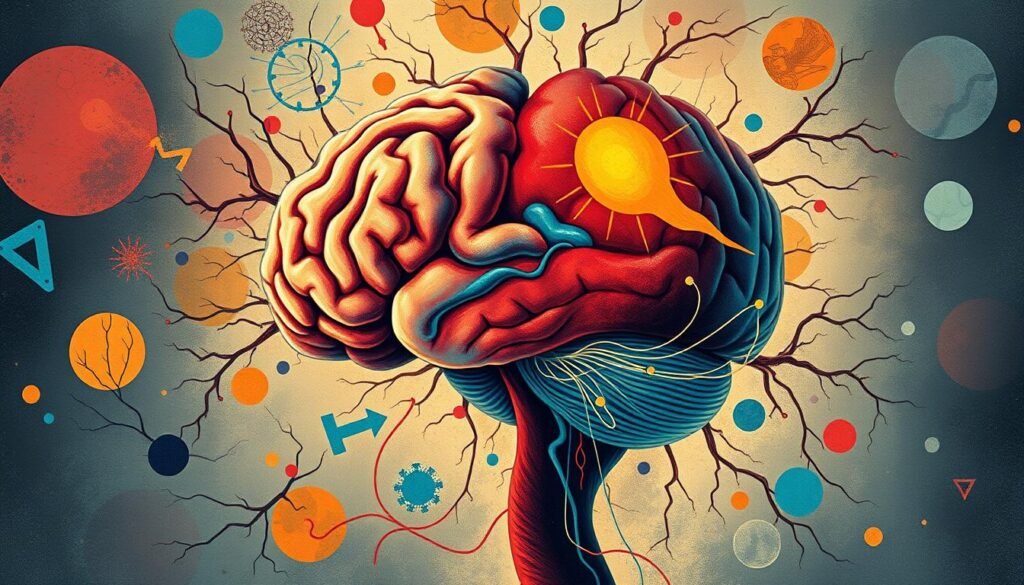Have you ever felt like your mind is caught in a storm of fear? Trying to understand what triggers anxiety in the brain is more than just science. It’s vital for those fighting anxiety disorders. Anxiety’s complexity comes from many places. These include our brain’s chemicals and our genes and surroundings. By figuring out these factors, we can find better ways to treat anxiety. This lets people take back control over their lives.
Key Takeaways
- Anxiety emerges from both brain activity and environmental experiences.
- Understanding the interaction of neurotransmitters is key to addressing anxiety disorders.
- The amygdala and other brain regions create a complex network affecting emotional responses.
- Genetic and environmental factors significantly influence anxiety levels.
- Effective anxiety treatment includes both medication and therapy options tailored to individual needs.
Understanding Anxiety Disorders
Nearly 1 in 5 adults in the United States battles anxiety disorders each year. These individuals experience deep fear and excessive worry. These feelings can disrupt how they live every day. Knowing the different types of anxiety disorders is key to helping them.
Definition and Types of Anxiety Disorders
Anxiety disorders include several conditions that vary in symptoms and severity. Identifying each type correctly is essential for effective treatment. Let’s look at a few:
- Generalized Anxiety Disorder (GAD) – Affects nearly 7 million American adults.
- Social Anxiety Disorder – Touches about 15 million U.S. adults equally across genders.
- Panic Disorder – Seen in about 6 million people, more common in women.
- Phobias – Including Specific Phobia, impacting 8% – 12% in the U.S.
Understanding different anxiety disorders is crucial. This is because their symptoms and the treatments they need vary greatly.
Common Symptoms of Anxiety
Anxiety disorders show up through several symptoms. These can greatly affect someone’s life. Here are some common symptoms:
- Persistent fear or panic
- Increased heart rate
- Trembling or muscle tension
- Shortness of breath
- Sleep problems
- Stomach issues
Spotting these signs is the first step in recognizing anxiety disorders. Often, they happen along with other mental health issues. Knowing these symptoms helps us find the right treatment sooner.
What Causes Anxiety in the Brain
Anxiety starts deep within the brain, especially in the limbic system. This area has parts like the amygdala and hippocampus. They are crucial for handling our emotions.
By studying how these parts of the brain work together, we can learn what leads to anxiety.
The Role of the Brain’s Limbic System
The limbic system plays a big part in feeling fear and emotions. When we see something scary, the amygdala gets very active. This can make us feel more anxious.
If this system isn’t working right, our emotions can get out of control. People with anxiety disorders have a super active limbic system. This makes it hard for them to manage how they feel.
Emotional Processing and Anxiety
Having an anxiety disorder changes how we process our feelings. This change can trap us in a cycle of constant worry and panic. If our brains can’t handle emotions well, we stay scared and uneasy.
Stress, past scares, or our genes can make these feelings worse. It’s important to understand how our feelings and anxiety are linked. This can help make life better for those who are struggling.

Neurotransmitters and Anxiety
It’s vital to understand how neurotransmitters and anxiety interact in our brain. Neurotransmitters like serotonin, GABA, and norepinephrine deeply affect our anxiety levels. They are key in mood control, so keeping them balanced is essential for emotional well-being. An imbalance increases the chance of feeling more anxious.
Key Neurotransmitters Involved
Different neurotransmitters play specific roles in anxiety management:
- Serotonin: Called the “feel-good” neurotransmitter, it regulates mood and affects happiness. Low serotonin can make anxiety worse.
- GABA: An important neurotransmitter for calming down the nervous system. More GABA activity means less anxiety and more relaxation.
- Norepinephrine: Tied to the body’s stress response, it helps with alertness. Too much can lead to anxiety.
How Imbalances Can Affect Anxiety Levels
An imbalance in these neurotransmitters can trigger more anxiety. For example, not having enough serotonin can cause anxiety and depression, making it hard to manage moods. Also, if GABA levels are off, it could lead to increased anxiety and make someone more prone to stress. How these neurotransmitters are regulated is key in dealing with anxiety triggers.
| Neurotransmitter | Role in Anxiety | Effects of Imbalance |
|---|---|---|
| Serotonin | Mood stabilization and emotional well-being | Increased anxiety and depression |
| GABA | Calming the nervous system | Heightened anxiety and stress reactions |
| Norepinephrine | Alertness and stress response | Increased anxiety and panic symptoms |

Brain Regions Involved in Anxiety
Learning about key brain areas linked to anxiety helps us understand why anxiety disorders happen and last. The amygdala and hippocampus are especially important. They deal with emotional signals and how we respond to threats.
The Role of the Amygdala
The amygdala is key in creating memories and reactions related to fear. Anxiety makes it overactive, linking closely to the condition. This leads to stronger fear and aggression, which affects everyday life.
When faced with threats, the amygdala readies us for a fight-or-flight reaction. These responses are natural but can be harmful if they happen too often in safe places.
The Importance of the Hippocampus
The hippocampus plays a big part in memory and emotional control. It works with the HPA axis to help us handle stress. Anxiety disorders can change how big and dense the hippocampus is.
This affects how people judge safety and danger around them. Using tools like fMRI, studies have shown the hippocampus’s role in anxiety. They show how brain connections related to anxiety develop early and last a lifetime.

The links between these areas point to the need for treatment that’s specific to each person. Understanding the amygdala and hippocampus interaction lays the groundwork for new, suited therapies.
To learn more about how brain regions impact anxiety, check out this research on anxiety cues found. It offers more insights into the underlying causes and supports finding better treatments.
Genetics of Anxiety Disorders
The genetics of anxiety disorders is key to understanding these conditions. It shows that traits and family history play a big part in risk factors for anxiety. These genetic factors can make some people more prone to anxiety, especially when combined with stress from the environment.
Inherited Traits and Family History
Studies point to a strong genetic link to anxiety disorders. For example, research finds that if parents have generalized anxiety disorder (GAD), their children are more likely to get it too. Their chances range from 2.1 to 2.6 times higher. Family and twin studies show a 6.1 odds ratio for GAD, showing it often runs in families.
The genetic part of GAD is about 31.6%. There’s also a big genetic link to neuroticism, with a correlation of 0.80. This highlights how important family history is in figuring out anxiety risks.
Gene-Environment Interactions
The mix of genetics and environment matters a lot for anxiety disorders. Genes may set the stage for anxiety, but life events often trigger it. About a third of the genetics behind GAD also affect neuroticism. This means stress and other outside factors can make inherited anxiety worse. Knowing the physical signs of anxiety helps manage it early.
Environmental Factors and Anxiety
Environmental elements greatly influence anxiety. Different situations can increase anxiety, showing how outside factors affect mental health. It’s vital to understand these to help with anxiety.
Impact of Traumatic Events
Traumatic events like childhood abuse impact mental health for a long time. They can change how emotions are managed and how the brain develops. Studies show women face anxiety more than men, often due to abuse. Trauma leads to more anxiety disorders in those at risk.
Stressful Life Situations
Stressful events play a big role in anxiety. Divorce, money problems, and job fears can all raise anxiety levels. A survey found 32% worry about paying bills. Unemployed people, singles, and minorities often face more anxiety. We must address these issues to manage anxiety better.
Cortisol and Anxiety
Cortisol is key in our body’s stress response, closely linked with anxiety via the HPA axis. It’s crucial to understand this link to see how long-term stress affects our mental health. Normally, cortisol helps manage metabolism, the immune system, and blood pressure. Yet, constant high cortisol can lead to big mental health issues.
The HPA Axis Connection
The HPA axis plays a big role in handling stress. During stress, it tells the adrenal glands to release cortisol. A study in 2018 found cortisol levels spike nine times higher under severe stress than during calm times. This chronic HPA axis activation can mess up its function, increasing anxiety and risk of disorders.
Effects of Chronic Stress on Anxiety
Facing high cortisol levels for too long can cause emotional problems, cognitive issues, and physical illnesses. Symptoms like being on edge, not being able to sleep, and having a fast heartbeat can arise. This makes dealing with stress hard. Exercises, eating right, and practicing mindfulness can help ease these symptoms. Using stress management techniques, people can work on lowering their cortisol and reducing anxiety. Knowing about this connection is the first step towards better handling of anxiety disorders.
The Role of GABA and Serotonin in Anxiety
Learning how neurotransmitters like GABA and serotonin affect anxiety is key. They play major roles in mood and anxiety levels in the brain.
GABA’s Inhibitory Function
GABA, or gamma-aminobutyric acid, helps calm the brain as its main inhibitory neurotransmitter. It works to keep mood and anxiety levels stable. This is crucial for managing anxiety, stress, and fear.
GABA comes from glutamate, with an enzyme’s help. A drop in GABA activity can lead to various health issues, including hypersomnia and Huntington’s disease. Medications such as benzodiazepines act on GABA receptors to treat anxiety disorders.
Serotonin’s Impact on Mood Regulation
Serotonin is also key for mood. It affects our happiness and anxiety levels. Low serotonin can cause more anxiety and mood problems.
Eating foods high in serotonin’s building blocks helps our mood. Thus, approaches that raise GABA and serotonin can help those with anxiety.
| Neurotransmitter | Role | Associated Conditions | Food Sources |
|---|---|---|---|
| GABA | Inhibitory neurotransmitter; calming effect | Hypersomnia, Huntington disease | Fermented foods, green tea, mushrooms |
| Serotonin | Mood regulation; emotional well-being | Anxiety disorders, depression | Foods rich in tryptophan (e.g., turkey, nuts) |
Conclusion
Understanding what causes anxiety in the brain is important. Anxiety comes from things like neurotransmitter imbalances, genetic factors, and environment. About 40 million people in the U.S. have anxiety disorders. Managing mental health well means looking at anxiety from all sides.
Treatment for anxiety should do more than just ease symptoms. It should include therapy, like cognitive-behavioral therapy, and simple techniques for momentary relief. Mindfulness and breathing exercises are key. They help those with social anxiety, generalized anxiety disorder, and phobias.
It’s crucial to see how common anxiety disorders are, especially among women. Not enough people get the help they need. Looking ahead, we need better, complete treatment plans. These should help people with anxiety live better lives.